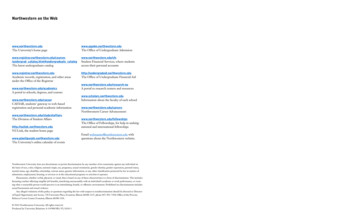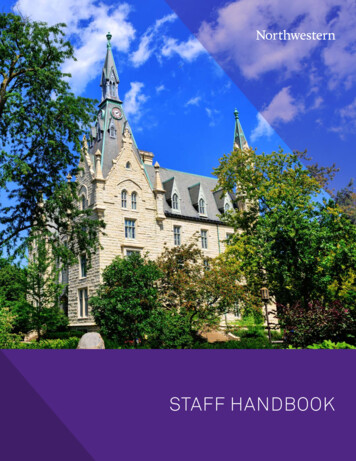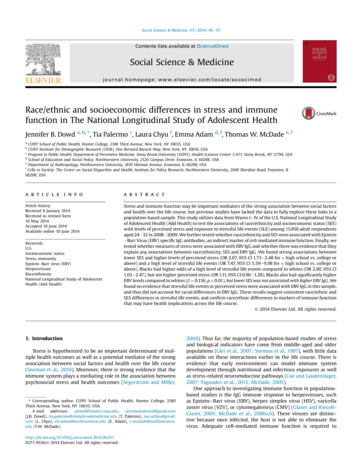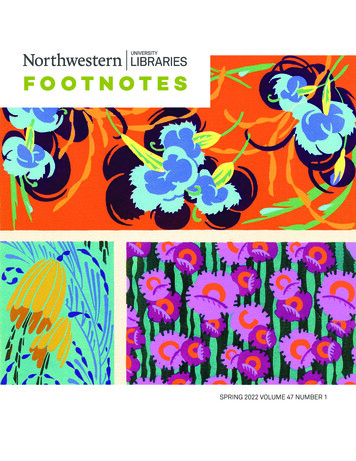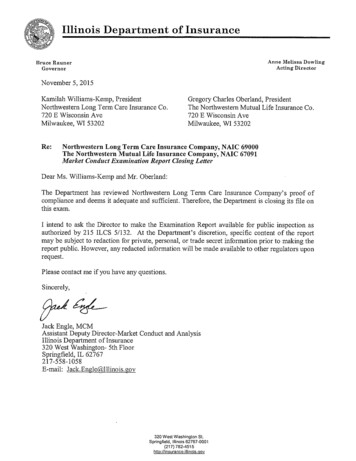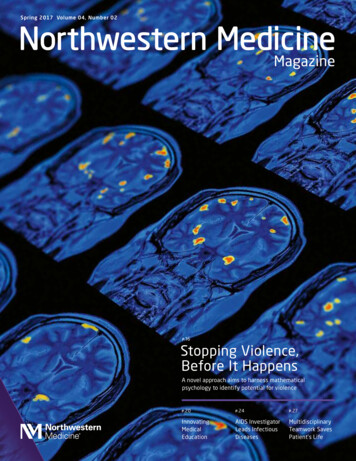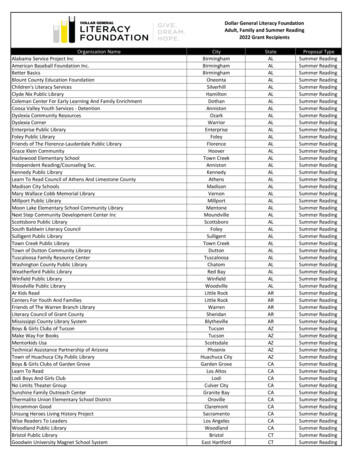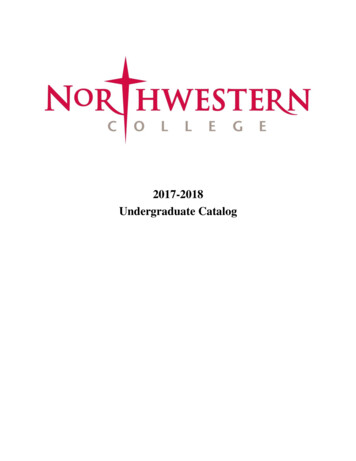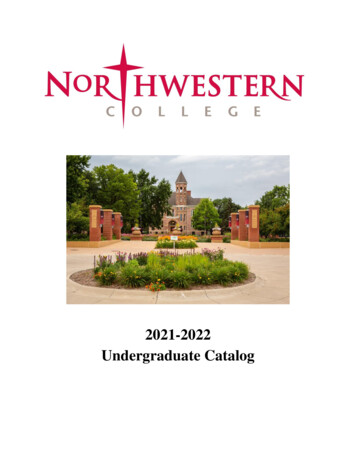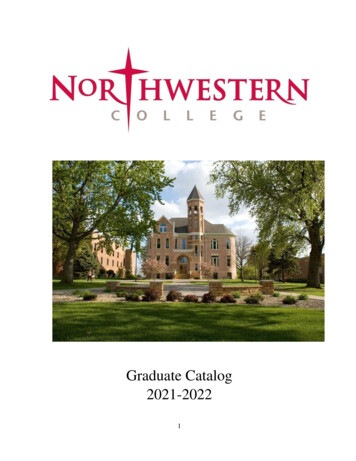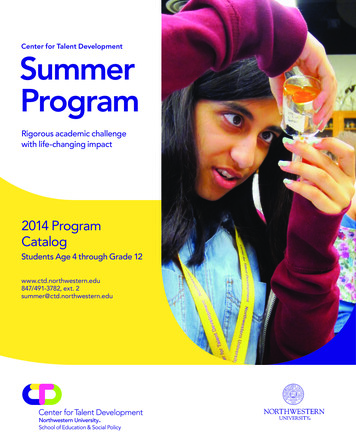
Transcription
Center for Talent DevelopmentSummerProgramRigorous academic challengewith life-changing impact2014 ProgramCatalogStudents Age 4 through Grade 12www.ctd.northwestern.edu847/491-3782, ext. 2summer@ctd.northwestern.edu
Welcome to the2014 Summer ProgramThe CTD Summer Program allows gifted students to delve deep into asubject of intrigue, build upon their strengths and connect with a communityof peers. From fast-paced enrichment options to accelerated, credit-bearingofferings, there is something for everyone!Catalog ContentsContact InformationAge 4 –Grade 3. . . . . . . . . . . . . . . . . . 5Half-day Courses. . . . . . . . . . . . . . . . . . . 6All-day Courses. . . . . . . . . . . . . . . . . . . 12Details, Fees &Application Procedure. . . . . . . . . . . . . 15Summer ProgramCenter for Talent DevelopmentNorthwestern UniversityGrades 4 – 6. . . . . . . . . . . . . . . . . . . . 191-Week Spark Program. . . . . . . . . . . . 222-Week Solstice Program . . . . . . . . . . 233-Week Apogee Program. . . . . . . . . . . 24Grades 7 & 8. . . . . . . . . . . . . . . . . . . 28Spectrum Program . . . . . . . . . . . . . . . . 28Grades 9–12. . . . . . . . . . . . . . . . . . . 35Equinox Program. . . . . . . . . . . . . . . . . 35Civic Leadership Institute . . . . . . . . . . . 42Program Details. . . . . . . . . . . . . . . . 43Enrichment Courses . . . . . . . . . . . . . . 43Credit-bearing Courses. . . . . . . . . . . . 44Campus Life Details. . . . . . . . . . . . . . . 45Program Fees &Application Procedure. . . . . . . . . . . . . 46Other CTD Programs. . . . . . . . . . . . . . . d.northwestern.eduFollow Usweb: www.ctd.northwestern.edu/summer“Talent Talk” blog: ctdblog.northwestern.edufacebook: www.facebook.com/CTDatNUtwitter: @CTDatNUCenter for Talent Development has beenaccredited as a nonpublic supplementary schoolby the North Central Association Commissionon Accreditation and School Improvement (NCACASI) since April 1, 1994. NCA CASI is recognizedby the U.S. Department of Education and hasmore than 100 years of experience in improvingeducational quality.
2014 Summer Programat a GlanceApplication period opens January 1, 2014Apply early! Regular application deadline for grade 4 –12 programs is May 19, 2014.Courses are filled on afirst-come, first-servedbasis and many coursesfill well before theapplication deadline. Regular application deadline for age 4 – grade 3 Leapfrog program is June 2, 2014. 50 late fee applies to applications received after the regular application deadline.STUDENTS AGE 4 (PreK)–GRADE 3 (grade level on January 1, 2014)Leapfrog ProgramLeapfrog provides fast-paced enrichmentcourses for students who have demonstrateda keen, early interest in learning. Half or allday, one-week courses are offered morningsand afternoons. Detailed program informationbegins on page 5. The Leapfrog programsite locations are listed on the SummerProgram website.New in 2014! Afternoon courses in Lake Forest Leapfrog Favorites now at Skokie andChicago sites Morning Math Club (early drop off)available in ChicagoProgram Dates:June 23–27Week 1, Leapfrog Favorites in Skokie, morningonly; all-day courses in ElmhurstJune 30–July 3Week 2, Leapfrog Favorites in Chicago,morning only; all-day courses in Elmhurst(4-day week)July 7–11Week 3, all sites except Elmhurst; morning,afternoon and all-day courses*July 14–18Week 4, all sites except Elmhurst; morning,afternoon and all-day courses*July 21–25Week 5, all sites except Elmhurst; morning,afternoon and all-day courses** Availability of afternoon and all-day coursesvaries by site.Sites:Chicago, Elmhurst, Lake Forest, Naperville,Palatine and Skokie2
2014 Summer Program at a GlanceGRADES 4–6 (grade level on January 1, 2014)Three program options: Spark (1 week), Solstice (2 weeks) or Apogee (3 weeks)Spark ProgramSpark is a week of fun, mind-stretching learning experiences. A residential option is available to students who choose the NorthwesternUniversity site in Evanston, Illinois. Detailedprogram information begins on page 19.Solstice ProgramThe Solstice program offers fast-paced enrichment courses in a two-week timeframe perfectfor extended study of a subject. Students atthe Northwestern University site may chooseto live on campus. Detailed program information begins on page 19.Apogee ProgramThe three-week Apogee program gives students the opportunity to take an enrichmentcourse that hones critical academic skills anddeepens knowledge and understanding of aparticular subject. Students may choose to reside on the Northwestern University Evanston,Illinois campus. Detailed program informationbegins on page 19.3Elmhurst College, Elmhurst, IL(commuter only)Program Dates:Northwestern University,Evanston, IL (residentialand commuter)Monday, June 23–Friday, June 27Program Dates:Monday, June 30–Thursday, July 3(4-day week)Sunday, June 29–Friday, July 4Elmhurst College, Elmhurst, IL(commuter only)Northwestern University,Evanston, IL (residentialand commuter)Program Dates:Monday, July 7– Friday, July 18Sunday, July 6–Friday, July 11Program Dates:Sunday, July 13– Friday, July 25Sunday, July 27– Friday, August 8Elmhurst College, Elmhurst, IL(commuter only)Program Dates:Monday, July 7– Friday, July 25Northwestern University,Evanston, IL (residentialand commuter)Program Dates:Sunday, June 29– Friday, July 18Sunday, July 20– Friday, August 8
2014 Summer Program at a GlanceGRADES 7 & 8* (grade level on January 1, 2014)Spectrum ProgramSpectrum offers three-week, in-depth enrichment and accelerated honors courses thatstretch young minds and provide challengebeyond grade level. Honors courses bear highschool credit. Detailed program informationbegins on page 28.*Students in grade 9 may apply; applicationswill be considered on a case-by-case basis.Elmhurst College, Elmhurst, IL(commuter only)Program Dates:Monday, July 7– Friday, July 25Northwestern University,Evanston, IL (residentialand commuter)Program Dates:Sunday, June 29– Friday, July 18Sunday, July 20– Friday, August 8GRADES 9–12 (grade level on January 1, 2014)Equinox ProgramEquinox combines fast-paced, advancedcoursework with the chance to explore collegeand careers in a hands-on way. Courses offerstudents the opportunity to earn high schoolcredit at the honors and Advanced Placement (AP) levels. Students can experience life on theNorthwestern University Evanston, Illinois campus as a residential participant or commutefrom home. Detailed program informationbegins on page 35.Civic LeadershipInstituteThe Civic Leadership Institute combines aninnovative service-learning curriculum with anunforgettable residential experience in theheart of downtown Chicago. The programhelps outstanding high school students develop the knowledge, experience and leadershipskills they need to make a positive impact onthe world. Details begin on page 42.Northwestern University,Evanston, IL (residentialand commuter)Program Dates:Sunday, June 29– Friday, July 18Sunday, July 20– Friday, August 8Sunday, June 29– Friday, August 1(5-week Advanced Placement science courses)Northwestern University,Chicago, IL (Loop Campus;residential only)Program Dates:Sunday, July 6–Friday, July 254
Leapfrog ProgramAge 4 (PreK)–Grade 3(grade level on January 1, 2014)Leapfrog engages students age 4 (PreK) through grade 3 in challenging academic adventures.Hands-on activities help children with demonstrated strength in math or verbal areas acquire andpractice new concepts in unique and interesting ways. Each half-day Leapfrog course is designed toaccommodate two grade levels: PreK/K, K/1, 1/2 or 2/3. This structure provides more course optionsand allows students with similar skills and abilities to be grouped together. Enrollment in PreKthrough K/1 courses is approximately 16 students; grades 1/2 and 2/3 courses accommodateapproximately 18 students.Apply Early! Application Period Begins January 1Notes: Enrollment option: Parents/guardians may enroll their children in anA.M. course, a P.M. course or both. Lunch/recess option: All students enrolled in both an A.M. course anda P.M. course are automatically enrolled in the 12 noon to 1 p.m. lunch/recess option at no extra cost. During weeks that both A.M. and P.M.courses are offered at a site, students enrolled in an A.M. course only(no P.M. course) may sign up for the lunch/recess option for an extrafee. (See page 16 for details.) Morning Math Club: At our Chicago site only, students enrolled inA.M. courses may also enroll in Morning Math Club. Students in theclub may be dropped off early, between 8-8:15 a.m., and participatein math games and activities until they are walked to class at 9 a.m.(See page 16 for details.)Courses are offered in Chicago, Elmhurst,Lake Forest, Naperville, Palatine and Skokie.For specific locations, please see the SummerProgram website at www.ctd.northwestern.edu/summer. You may enroll your child in oneor multiple weeks of Leapfrog courses.There are three different types of Leapfrogcourse offerings:Program Dates: Week 1: June 23-27Leapfrog Favorites in Skokie &Leapfrog All-day in Elmhurst Week 2: June 30–July 3(4-day week)Leapfrog Favorites in Chicago &Leapfrog All-day in Elmhurst Week 3: July 7–July 11 Week 4: July 14–July 18 Week 5: July 21–July 25 Half-day A.M. Courses meet from 9 a.m. to 12 noon(Monday through Friday). Half-day P.M. Courses meet from 1 p.m. to 4 p.m. (Mondaythrough Friday). All-day Courses are available for students in grade 3. Select all-daycourses are also available for students in grade 2. All-day coursesmeet from 9:15 a.m. to 3:45 p.m. with a break for lunch (except inElmhurst, where courses meet from 8:30 a.m. to 2:45 p.m.). Seepage 12 for details.5“Leapfrog is academic learningwhile feeling like play.”—2013 Leapfrog parent
Leapfrog Half-day Course Reference ChartKEYCH ChicagoLF Lake ForestNP NapervillePA PalatineSK SkokieEnroll your child in a course for his or her grade level as of January 1, 2014.Select course topics that best fit your child’s academic strengths asdetermined through test scores and/or other academic measures.Leapfrog FavoritesA.M. 9 a.m.–12 noonP.M. 1 p.m.–4 p.m.Weeks 1 & 2: Half-day CoursesJune 23–27 & June 30–July 3June 23–27June 30–July 3COURSE NUMBER(grade Level)COURSETITLESUBJECTAREASKAMCHAMA (PreK/K)If I Ran the ZooEnglish & WritingXXA (K/1)Click! Telling Stories with PhotosEnglish & WritingXXA (1/2)Comic Book CharactersEnglish & WritingXXA (2/3)Life on MarsEnglish & WritingXXB (PreK/K)Playground MathMathematicsXXB (K/1)Blocks & BlueprintsMathematicsXXB (1/2)Treasure MapsMathematicsXXB (2/3)Number Devil: Adventures in MathMathematicsXXC (PreK/K)Big Cats: Lions, Tigers & MoreScienceXXC (K/1)Whale Talk: How Sea Creatures CommunicateScienceXXC (1/2)Dinosaur Discovery: Paleontology UnearthedScienceXXC (2/3)Kitchen Chemistry: Edible ExperimentsScienceXXWeek 3: Half-day CoursesJuly 7–11COURSE NUMBER(grade A (PreK/K)Yellow SubmarineEnglish & WritingXXX3-A (K/1)South Pole: Journey to AntarcticaEnglish & WritingXXX3-A (1/2)Survivor: Bermuda TriangleEnglish & WritingXX3-A (2/3)Climbing Mount EverestEnglish & WritingX3-B (PreK/K)The Secret Lives of NumbersMathematics3-B (K/1)Extreme Code Breaking3-B ticsXXXXXXMath for SpiesMathematicsXXXXXX3-B (2/3)Hackproof PasswordsMathematicsXXXXXX3-C (PreK/K)Zoo VetsScienceXXXXXXXXXX3-C (K/1)Blood & Bones: The Human BodyScienceXXXXXXXXXX3-C (1/2)Grossology: Fascinating Systemsof the Human BodyScienceXXXXXXXXXX3-C (2/3)Brain SurgeryScienceXXXXXXXXXX3-S (PreK/K)Codes & Symbols Math StudioCreative StudiesXXXXX3-S (1/2)Codes & Symbols Math StudioCreative StudiesXXXXXX6
Week 4: Half-day CoursesJuly 14–18COURSE NUMBER(grade A (PreK/K)Mouse House: Tiny Habitats inStories & NatureEnglish & WritingXXX4-A (K/1)Horses, Wild & TameEnglish & WritingXX4-A (1/2)Shark Attack! Underwater MythbustingEnglish & WritingX4-A (2/3)NPPMPAAMPAPMSKAMSKPMXXXXXXXXXXXSign of the Gorilla: Extraordinary ApesEnglish & WritingXXXXX4-B (PreK/K)Puzzle Party: Riddles, Mazes & MoreMathematicsXXXXXX4-B (K/1)Think Tank: Games for BrainsMathematicsXXXXXX4-B (1/2)Mind Bogglers: Predictions & ProbabilityMathematicsXXXXXX4-B (2/3)Brain Twisters: Multiplication & FractionsMathematicsXXXXXX4-C (PreK/K)Building BridgesScienceXXXXXXXXXX4-C (K/1)Digging Canals & TunnelsScienceXXXXXXXXXX4-C (1/2)Designing Sailing ShipsScienceXXXXXXXXXX4-C (2/3)Raising Skyscrapers & TowersScienceXXXXXXXXXX4-S (PreK/K)Puzzles & Games Math StudioCreative StudiesXXXXX4-S (K/1)Puzzles & Games Math StudioCreative StudiesXXXXXWeek 5: Half-day CoursesJuly 21–257COURSE NUMBER(grade A (PreK/K)Pirates & TreasuresEnglish & WritingXXX5-A (K/1)Monsters & MermaidsEnglish & WritingXX5-A (1/2)Gods & GoddessesEnglish & WritingX5-A (2/3)Castles & DragonsEnglish & Writing5-B (PreK/K)Coins & Currency: Money in Our World5-B sXXXXXXBank on It: Savings & CheckingMathematicsXXXXXX5-B (1/2)Business Start UpMathematicsXXXXXX5-B (2/3)Taking Stock: The Ins & Outsof the Stock MarketMathematicsXXXXXX5-C (PreK/K)Surprising Spills & MessesScienceXXXXXXXX5-C (K/1)Awesome Explosions & CollisionsScienceXXXXXXXX5-C (1/2)Lost & Found: The Best Failed ExpeditionsScienceXXXXXXXX5-C (2/3)Micro-Mistakes of the Great ScientistsScienceXXXXXXXX5-S (PreK/K)Business Math StudioCreative StudiesXXX5-S (1/2)Business Math StudioCreative StudiesXXXX
Leapfrog Half-dayCourse DescriptionsWeek 1: June 23–27Leapfrog Favorites in SkokieWeek 2: June 30–July 3Leapfrog Favorites in Chicago(4-day compacted week)A select group of our most popular Leapfrogcourses will be offered at our Skokie andChicago locations. All courses meet from 9a.m. to 12 noon daily. Skokie Favorites run fivemornings, Monday through Friday. ChicagoFavorites run in a compacted course scheduleoffered over four mornings, Monday throughThursday, with no class on July 4.English & WritingFavoritesStudents with strong verbal ability may enrollin an English & Writing course. Courses aredesigned to meet the needs of academicallyadvanced students (performing 1.5 to 2 yearsabove grade level) while allowing them to workwith same-age peers. Identify the appropriatesection for your child based on his/her gradelevel on January 1, 2014. The course code andgrade level precede each course title.1-A (PreK/K) If I Ran the Zoo (Skokie)2-A (PreK/K) If I Ran the Zoo (Chicago)Students take on the roles of zookeepers andveterinarians to make important decisionsabout which animals to keep in their zoo andhow to care for them. The young zookeepersconduct research and design animal habitats,create signs and other zoo literature anddiscuss ethical issues related to zoo life andendangered animals. Early literacy skills aredeveloped through drawing, dictation andemergent writing.1-A (K/1) Click! Telling Stories with Photos(Skokie)2-A (K/1) Click! Telling Stories with Photos(Chicago)Photographs are both inspiration and illustration as students combine words and imagesin the creation of original stories and poems.Students take their own photos as well ascollect photos from families, magazines andother sources.1-A (1/2) Comic Book Characters (Skokie)2-A (1/2) Comic Book Characters (Chicago)What do Babymouse, Spiderman andCharlie Brown have in common? They are allcharacters found in comic books, comic stripsand graphic novels. Students create originalworks using a combination of creative writingand drawing.1-A (2/3) Life on Mars (Skokie)2-A (2/3) Life on Mars (Chicago)A space colony is going to be established onMars. Students take on the roles of youngastronauts preparing to live together in spaceand in a strange new world. What will theyneed to bring? How will they prepare for theirjourney? Students work together, researchingand writing their ideas and plans, to determinehow the colony will be established and thenblast off on their imaginary journey.Mathematics FavoritesStudents with an identified strength in mathmay enroll in a Mathematics course. Identifythe appropriate section for your child basedon his/her grade level on January 1, 2014. Thecourse code and grade level precede eachcourse title.1-B (PreK/K) Playground Math (Skokie)2-B (PreK/K) Playground Math (Chicago)How many rectangles can be found in a set ofmonkey bars? How do you measure the angleof a slide and how does the angle of inclinehelp you go down faster (or slower)? Studentsare introduced to a variety of tools and geometric concepts for hands-on exploration ofeveryone’s favorite play space: the playground!1-B (K/1) Blocks & Blueprints (Skokie)2-B (K/1) Blocks & Blueprints (Chicago)A blueprint is a drawing that shows the designof a building or an outdoor area. Using blocksand other construction materials, students create models of buildings and spaces, then usegeometry tools and concepts to draw blueprints and scaled diagrams of their creations.Science FavoritesStudents with strong math or verbal abilitymay enroll in a Science course. Identify theappropriate section for your child based onhis/her grade level on January 1, 2014. Thecourse code and grade level precede eachcourse title.1-C (PreK/K) Big Cats: Lions, Tigers & More(Skokie)2-C (PreK/K) Big Cats: Lions, Tigers & More(Chicago)As novice zoologists, students explore thecaptivating world of big cats from lions to jaguars to unique cat hybrids. Students “travel”across the globe in order to observe anddiscuss how these astounding animals interactwith their habitat and each other. Throughresearch and hands-on activities, students areintroduced to the incredible world of thesemarvelous mammals and gain an appreciationof wildlife conservation.1-C (K/1) Whale Talk: How Sea CreaturesCommunicate (Skokie)2-C (K/1) Whale Talk: How Sea CreaturesCommunicate (Chicago)Can a whale tell a joke or sing a lullaby?Whales make amazing sounds to communicatewith each other. In this course, mini-marinebiologists learn how these intelligent creaturesof the deep use echolocation, clicks, whistlesand music-like tones to communicate.Activities and projects introduce students tothe incredible ways these marvelous mammalsuse sound to connect and make sense oftheir world.1-B (1/2) Treasure Maps (Skokie)2-B (1/2) Treasure Maps (Chicago)Making maps, or cartography, is a process thatinvolves many different geometry skills. Addingthe mystery of buried treasure makes the process even more fun! Students apply principlesof geometry and concepts of cartography tocreate their own treasure maps and use classmates’ maps to find their treasure!1-B (2/3) Number Devil: Adventures in Math(Skokie)2-B (2/3) Number Devil: Adventures in Math(Chicago)Number Devil is a book about Robert, a boywho discovers the amazing world of numbers,such as infinite numbers, prime numbersand Fibonacci numbers. The Number Devil’svisualizations of these high-level math concepts offer a starting point for projects in drawing, painting, construction and dramatic play.Join us in the rollicking dream world of theNumber Devil!8
Week 3 (July 7–11)You’re In the StoryStories are a powerful way to communicateideas, emotions and information. Settings fromthe bottom of the ocean to towering mountains provide the backdrop for students tocreate and act out their own stories. Studentsstrengthen language and literacy skills throughdramatic play, creative writing and storytelling, reading and research, and collaborativeproblem solving.NEW! 3-A (PreK/K) Yellow SubmarineThe words to the Beatles’ song, “YellowSubmarine,” inspire students to play, imagine,draw and write about life under the waves ina sea of green. The class becomes a maritimecrew as they learn the roles of pilots, navigators, explorers and scientists. Students honetheir language and early writing skills throughcreative storytelling and dramatization.1-C (1/2) Dinosaur Discovery:Paleontology Unearthed (Skokie)2-C (1/2) Dinosaur Discovery:Paleontology Unearthed (Chicago)Dinosaurs may have roamed the earth millionsof years ago but they are just as fascinatingtoday! Aspiring paleontologists learn about themany species of these “terrible lizards” fromthe famous T-Rex to the only recently identifiedLinheraptor. Students unravel the mysteries ofhow these animals lived, looked and died asthey literally and figuratively “dig” deep intothe fossil record. Join our expedition!1-C (2/3) Kitchen Chemistry:Edible Experiments (Skokie)2-C (2/3) Kitchen Chemistry:Edible Experiments (Chicago)Did you know your kitchen is really a chemistrylab? In this course, epicurean explorers unravelmysteries of food preparation through chemistryand human biology. Students employ hypothesis testing, create and record chemical reactionsand observe how many of the foods we love arethe result of scientific processes at work. Kitchenchemists learn about physical and chemicalchanges, how they happen and how they affectour food and bodies.NOTE: Students will be handling and tastingfood products in this course (not includingpeanuts or tree nuts). Students with food allergies are advised not to take this course. Pleasecontact the Summer Program staff with anyquestions or concerns.English & WritingStudents with strong verbal ability may enrollin an English & Writing course. Identify theappropriate section for your child based onhis/her grade level on January 1, 2014. Thecourse code and grade level precede eachcourse title.9 Creative Studies CourseNEW! 3-A (K/1) South Pole:Journey to AntarcticaAs explorers and scientists “traveling” to thecoldest continent on the earth, students learnabout the biodiversity of Antarctica and theanimals living there, such as penguins andseals. Students imagine and create theirown research station at the South Pole andproduce guidebooks, articles and stories aboutAntarctica. Students encounter a variety ofchallenges that they must research, discussand solve together.NEW! 3-A (1/2) Survivor: Bermuda TriangleA mysterious region in the Atlantic Ocean, theBermuda Triangle is the source of many storiesand legends involving disappearing ships andstrange sea creatures. Students imagine themselves in the roles of explorers sailing throughthe Bermuda Triangle as they create stories,murals and skits representing their ideas andtheories about the curious happenings at sea.NEW! 3-A (2/3) Climbing Mount EverestAs climbers seeking to reach the top of Everest, the Earth’s highest mountain, studentsrole play and imagine the challenges of thismonumental feat. Students research weather,topography, geography and climbing techniques, read the stories of previous climbers,and create, through writing and illustrations,their own imagined accounts of the gruelingand heroic journey.Week 4 (July 14–18)Animal Friends & FoesMice, horses, sharks and gorillas are all fascinating animals that have been featured inbooks, articles and stories. Students explorethe connections between animals and humans,both real and imagined, as they develop andpractice language, research and writing skills.NEW! 4-A (PreK/K) Mouse House:Tiny Habitats in Stories & NatureStorybook mice, such as Stuart Little, fascinatereaders with their tiny furniture and cozy littleliving spaces. Students explore how the homesof storybook mice compare to the habitatsof real mice. Read-alouds and storytellingcombine with an introduction to research skills,critical thinking, and creative writing.NEW! 4-A (K/1) Horses, Wild & TameLong ago, all horses were wild and free buthumans have found ways to train these beautiful, strong animals to carry riders and pullheavy loads. Students learn about the wayshumans and horses work together by exploringboth fiction and nonfiction stories and resources. Creative projects such as writing stories andskits allow students to study all types of horses,from ponies to stallions.NEW! 4-A(1/2) Shark Attack!Underwater MythbustingSharks are the most feared creatures in theocean, but actual shark attacks on people arevery rare. As aspiring mythbusters, studentsresearch how and why sharks inspire fascination and fear, use critical thinking to determinethe real facts, and document their findings andideas with both words and images.NEW! 4-A (2/3) Sign of the Gorilla:Extraordinary ApesKoko, a female gorilla born in the SanFrancisco Zoo, learned to use gestures fromAmerican Sign Language to communicatewith her trainers. Students explore the storyof Koko and other extraordinary apes andimagine the possibilities for future communication between animals and humans. Reading,writing, researching, illustrating, diagramming,demonstrating and dramatizing are justsome of the skills students incorporate intocreative projects.Week 5 (July 21–25)Stories, Fact & FictionSince the beginning of time, humans haveshaped and defined history using their imaginations and influence. As they explore theroots, truths and falsehoods around piratesand monsters, myths and dragons, studentssharpen their writing, research and critical–thinking skills. Readings coupled with writingprojects, visual displays and drama activitiesprovide students with opportunities to examine facts and fiction.5-A (PreK/K) Pirates & TreasuresThrough fictional and non-fictional literature,students discover pirates and treasures, decipher codes and hunt for clues using readingsand maps. Participants study the historical andcultural forces that surrounded pirating in dif-
ferent parts of the world at different time periods. To develop writing skills, students write,draw and dictate journal entries and stories.5-A (K/1) Monsters & MermaidsStudents expand their reading, researchingand listening skills through the explorationof fantastic tales about mysterious creatures,such as the Loch Ness monster and singingmermaids. Students craft their own accounts ofmonster sightings in formats such as illustratednewspaper accounts, live reports and shortstories, which also develop writing skills.5-A (1/2) Gods & GoddessesHow did Zeus escape being swallowed byhis father? Why is Aphrodite the goddess oflove and beauty? In this course, students goback in time to find answers to questionssuch as these. As participants discuss theirreadings they strengthen their vocabulary,comprehension and analytical skills. Studentscreate their own stories exploring events andnatural phenomena through the actions ofgods and goddesses, synthesizing their newfound knowledge.5-A (2/3) Castles & DragonsThe colorful history of Medieval Englandcomes alive through the legends and stories ofknights and quests. After gaining a base knowledge of medieval history through research, students collaborate to create their own projectsrepresenting the ideas and stories that havecaptured their imaginations.Mathematics CoursesStudents with an identified strength in mathmay enroll in a Mathematics course. Identifythe appropriate section for your child basedon his/her grade level on January 1, 2014. Thecourse code and grade level precede eachcourse title.Week 3 (July 7–11)Codes & SymbolsThe world is full of codes and symbols andmath skills help decipher them! From numberpatterns to complex ciphers, young codebreakers develop strategies and discover thesecrets behind a fascinating variety of codes.3-B (PreK/K) The Secret Lives of NumbersHow many different ways can you depict thenumber three? A digit is just one symbol thatrepresents a numerical concept. Amazingsecrets are revealed as students practice identifying and using symbol systems to representmathematical ideas.3-B (K/1) Extreme Code BreakingBreaking a code often involves identifying apattern. Morse code, for example, is a patternof dots and dashes. Students identify patternsof numbers, letters, sounds and symbols anduse what they have learned to create their ownsecret codes.3-B (1/2) Math for SpiesThere’s more to being a spy than just wearinga disguise. Spies also have to be expert mathematicians. In this course, aspiring spies usemath to create secret codes, plot the coordinates of enemy hideouts and discover, throughlogical reasoning, the identities of other spies.3-B (2/3) Hackproof PasswordsHow do computer passwords work? Whyare some passwords better than others? Thiscourse explores a variety of methods for usingand creating passwords and passcodes, anddevelops the mathematical and critical-thinkingskills necessary to create master passwords.Codes & Symbols Math Studio(Afternoon only)3-S (PreK/K)3-S (1/2)Students extend their growing knowledgeof codes, patterns and sequences throughactivities such as creating maps, buildingRube Goldberg machines, dramatizing storysequences and producing musical patterns.Week 4 (July 14–18)Puzzles & GamesFind the right strategy and a solution willemerge! With a focus on logical thinking,young mathematicians use reasoning, estimation and mental math skills as they playgames, work through puzzles and tackle wordproblems.4-B (PreK/K) Puzzle Party:Riddles, Mazes & MorePuzzles, tangrams, mazes and riddles challengestudents to seek solutions using computation,logic and deduction.mathematical challenges keep young mindschurning as they use fractions and multiplication to arrive at solutions.Puzzles & Games Math Studio(Afternoon only)4-S (PreK/K)4-S (1/2)Clay, foam and wood are just three of thematerials students use to deepen theirunderstanding of the math concepts relatedto puzzles and games. Students invent games,build puzzles and analyze the game-like qualities in the world around them.Week 5 (July 21–25)Dollars & Cents: Business BasicsWhy do you need money? How do youmake money? What does it take to createa successful business? From working withbudgeting, currencies and systems for trackingsuccess to analyzing profit/loss a
accredited as a nonpublic supplementary school by the North Central Association Commission on Accreditation and School Improvement (NCA CASI) since April 1, 1994. NCA CASI is recognized by the U.S. Department of Education and has more than 100 years of experience in improving educational quality. Contact Information. Summer Program
